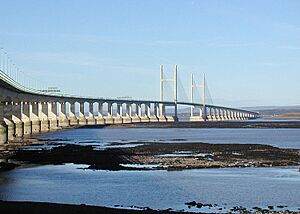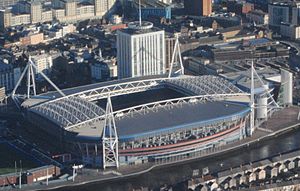John Laing Group facts for kids
 |
|
|
Formerly
|
John Laing & Sons |
|---|---|
| Private | |
| Industry | Infrastructure |
| Founded | 1848 |
| Headquarters | London, England |
|
Key people
|
Andrew Truscott (CEO) |
| Parent | KKR |
John Laing Group is a company from Britain. They invest in, build, and manage big projects like roads, railways, hospitals, and schools. They often work with the government using special agreements called Public-Private Partnerships (PPP) or Private Finance Initiatives (PFI). The company used to be listed on the London Stock Exchange, which is where shares of companies are bought and sold. Later, a company called KKR bought John Laing Group.
Contents
History of John Laing Group
Early Days and Growth (1848-1950s)
The company started in 1848. A man named James Laing and his wife, Ann Graham, began building houses in a place called Cumberland. They bought land for £30 and built their first house. The money they earned from that house helped them build more. Later, the family and their business moved closer to Carlisle.
When James Laing passed away in 1882, his son, John Laing, took over. John started taking on bigger building jobs, but he kept the business focused on the Carlisle area. John's son, John William Laing, joined the company before he was 20. The company then became known as John Laing & Son.
By 1910, John William Laing was in charge. He hired more people and started building larger projects, like factories. In 1920, the company officially became a limited company. Two years later, its main office moved to a large site in Mill Hill, north-west London.
During World War II, John Laing Group helped build important parts of the Mulberry harbour units. These were temporary floating harbors used during the D-Day landings. Their work during the war and in the years of rebuilding afterwards made the company very well-known.
In 1950, William Kirby Laing and John Maurice Laing, who were the fifth generation of the Laing family, joined the company. In January 1953, John Laing & Sons was listed on the London Stock Exchange for the first time. At that point, the company had about 10,000 employees.
Expanding and Changing Focus (1960s-2000s)
Under William Kirby Laing and John Maurice Laing, the company continued to grow. They won contracts to build power stations and started building roads. They also kept building houses.
In 1985, Martin Laing, from the sixth generation of the family, became the chairman. He decided the company should try new things. Building homes became a big part of their growth, not just in the United Kingdom but also in places like the Middle East, Continental Europe, and the United States.
In 1969, the company made its first investment in a big infrastructure project. They invested in a toll road in Spain. Another important step was in 1990 when they helped build the Second Severn Crossing. This was their first project using a Public-Private Partnership (PPP).

In 1995, John Laing supported a team that bought the Chiltern Railways train franchise. They later bought a controlling share in Chiltern Railways in 1999.
By the late 1990s, the business grew very quickly. However, they started losing money on some big building projects. These included the Millennium Stadium in Cardiff and the National Physical Laboratory. Because of these problems, the company cut 800 jobs in 2001. They also sold their construction part of the business to O'Rourke for just £1.
After this, John Laing Group decided to focus mainly on PPP and PFI projects. In 2002, they sold their property development parts to Kier Group. They also sold their house-building part to George Wimpey that same year.

Recent Years and New Ownership (2006-Present)
In December 2006, a company called Henderson Group bought John Laing plc. A year later, in 2008, the part of the company that ran trains, called Laing Rail, was sold to Deutsche Bahn. Laing Rail had interests in train lines like Chiltern Railways and London Overground Rail Operations.
In 2012, John Laing was part of a group called Agility Trains. This group won a big contract to design and build new long-distance trains for the Intercity Express Programme. In October 2013, the company sold its facilities management business to Carillion.
The John Laing Environmental Fund was started in 2014. In February 2015, the company was listed on the London Stock Exchange again.
In September 2021, KKR completed its purchase of John Laing Group. The deal was worth about £2 billion.
Important Projects John Laing Invested In
Some of the important projects John Laing has invested in include:
- The Intercity Express Programme (sold in 2018)
- The Greater Manchester Waste Recycling and Combined Heat & Power Programme
- The New Royal Adelaide Hospital in Australia
- The A1 Autostrada in Poland
- The Denver Eagle P3 Project in the United States
Past Operations
Laing Construction
John Laing used to have a construction division. This part of the company built many famous buildings and structures. It is now part of Laing O'Rourke. Some of their projects included:
- The Chapelhouse Reservoir (1900)
- Catterick Camp (1930)
- Shenley Hospital (1932)
- Warwick Hall in Cumbria (1933)
- Holme Moss transmitting station (1951)
- The Spelga Reservoir (1957)
- The Electra Building in Vancouver (1957)
- Government House, Victoria (1959)
- The M1 motorway (1959)
- Coventry Cathedral (1962)
- New Century House, Manchester (1962)
- County Hall, Durham (1963)
- The Bull Ring in Birmingham (1964)
- Carlisle Civic Centre (1964)
- Lanark County Buildings (1964)
- Westway (1970)
- Clifton Cathedral (1973)
- St Thomas' Hospital North Wing (1975)
- London Central Mosque (1977)
- The Freeman Hospital in Newcastle upon Tyne (1977)
- St David's Hall in Cardiff (1982)
- Mount Pleasant Airfield (1986)
- Borders General Hospital (1988)
- Newcastle Law Courts (1990)
- Stansted Airport Terminal Building (1991)
- Teesside Combined Court Centre (1991)
- Bradford Law Courts (1993)
- The Sizewell B nuclear power station (1995)
- Sheffield Law Courts (1995)
- The Second Severn Crossing (1996)
- Bridgewater Hall in Manchester (1996)
- The British Library (1997)
- No 1 Poultry in the City of London (1997)
- The Millennium Stadium in Cardiff (1999)
- The Joint Services Command and Staff College (2000)
- Norfolk and Norwich University Hospital (2001)
Laing Rail
Laing Rail was a part of the company that owned and operated train services. It ran Chiltern Railways and was a joint operator of London Overground with MTR Corporation. It also had a share in Wrexham & Shropshire. In 2008, Laing Rail was sold to the German train operator Deutsche Bahn.

